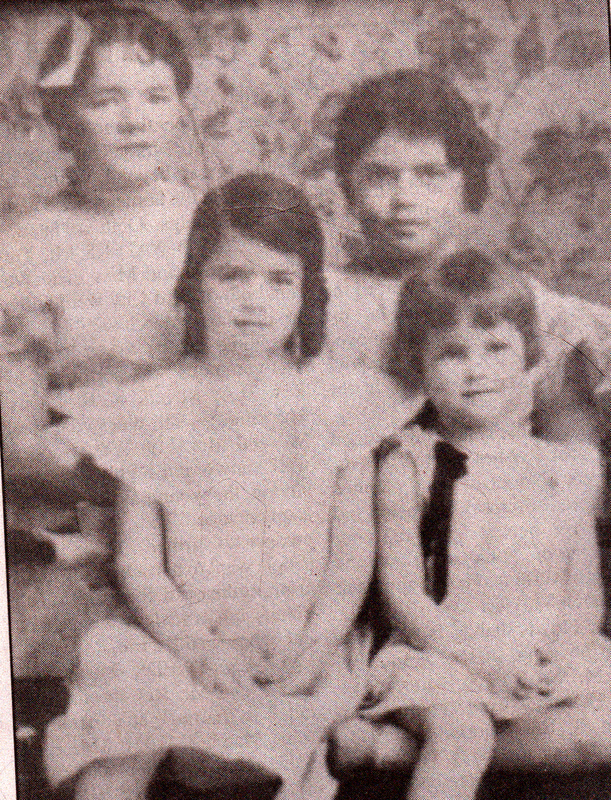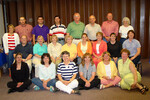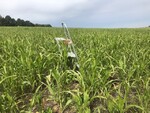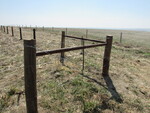Posted date: Apr 11, 2021
by: Dianna Padgett
529 Views
My education began in the Sunny Ridge Schoolhouse District 44 located two and half miles north of our home. When I attended school there were enough children living in our rural area to employ a teacher. I had two boys in my class to begin with, Willard Walz and Walter Brown. Willard moved away in a couple of years leaving only Walter and I. We were both good students so were competitive in all of our work. Our teacher for the first seven years was Mrs. Edith Maness. She was from Goodland but lived in a small house not far from the schoolhouse going home only on week-ends.
She was a beautiful and excellent teacher. She would write lots of addition- subtraction and multiplication problems on the board and point to them with a yard stick timing Walter and I to see which could give the answers more quickly. Occasionally there was a candy bar as a reward after a certain number of winnings. We all sat at our desks until our class was called on for reading, writing, arithmetic, spelling, or geography. At this call we went to a small bench in front of the teacher's desk where we were to recite, answer questions and be prepared for whatever the teacher required of us. The students in other classes could hear all that transpired but had to be able to concentrate on their own studies at the same time. Some educators feel that extra information was absorbed by all the pupils while they were in this environment. The teacher had to conduct all of the eight grades in every subject, grade papers, give examinations, prepare daily lessons, and maintain order among children from five years old to sixteen. Our school had thirty-five children at one time in the one room school. The teacher also had to build a fire each morning in the cold schoolhouse, get the coal or wood and have the room warm by the time that students arrived. The task of cleaning the schoolhouse was filled by the teacher, too. A red colored floor cleaner compound was put on the floor each day at the close of school and swept with a large black brush broom from the wooden floors. Blackboards had to be washed daily and the schoolhouse was decorated with seasonal art work to make it attractive. Our schoolhouse had a piano so if the teacher could play it was a great advantage. Since Mrs. Maness was a fine pianist she accompanied us for a daily period of singing. When we came in from recess at noon she read a story to us for about fifteen minutes to be continued each day. We sat quietly listening intently. I now wonder how she selected a story which would hold the interest of children of such varied ages.

We gave a program annually which we practised for weeks in preparation for. There were always plays, individual special numbers, songs, readings, dances. I always sang, tap danced, danced the Charleston, gave readings and acted in plays. My favorite music to dance to was Whispering which Mrs. Maness played well and was fun to dance to. The schoolhouse was filled with people on the night of the program. Long boards were brought in and supported by cinder blocks for people to sit on. We had a small stage with curtains that pulled and would stay in the entry way between numbers trying to be quiet. After the program we had a box supper where people fixed a box beautifully and put especially good food in it and someone in the audience bought the box. The boys and men bought the boxes to eat with the girls or women. No girl was supposed to let anyone see her box before it was auctioned off. If a boy liked a girl he would try to buy her box to eat with her. It was scary for fear that someone whom you did not like would buy your box. Many boxes were elaboratedly decorated in the shape of things. Crepe paper and tissue paper were used. It was great fun!
Sometimes during the year the community would have gatherings at the schoolhouse and play games. It was fun to play outside with the boys on these nights.
At recess time we played soft ball but since I was not a fast runner or a good hitter I was usually not chosen until all of the good players were taken. We also played with other schools in the adjoining area occasionally to compete with them. Other games we played were Annie-over where the ball is throw over the school house after sides are chosen. Whoever catches it can run around the schoolhouse and try to touch someone from the opposing side with the ball to eliminate the player. This is done until one player remains and becomes the winner. When it snowed we played Fox and Geese. Trails were made in the snow on which the foxes must pursue the geese.
When I was in the seventh grade there were three older girls in the eighth grade named Opal Brown, R-Jane Steller and Ardith Steele. The teacher allowed us to walk down to a deep ditch a small distance east of the schoolhouse to make a cave in the ditch with thistles for a roof. We cleaned the ditch out and brought small rugs from home, and boxes to sit on, and table cloths and kitchen things to play house during recess. It was so cozy and exciting to have our own private place. This made the boys mad because they were isolated so consequently Walter Brown jumped in on the thistle roof smashing our cave in. The teacher wouldn't allow us to go there anymore so we had to abandon the ditch house. Sometimes Mrs. Maness would let us
go outside early if we finished our work. Walter Brown and I with a few others often got to play extra times. One day Walter became angry about something, lost his temper, laid on the ground and began kicking. He did not realize that he was lying in a red ant pile until he began screaming and jumping about wildly. He had ants in his ears, in his hair and in his clothing which were biting him. The teacher was angry so that was the last time that we were allowed to go out except during recess.
We had a merry-go-round which children climbed inside of and pushed to make it go fast for those sitting on the outside edge. There were large low iron bars near where our feet ran. One day several of us were inside pushing with all of our might. Paul DeGood was inside pushing when suddenly he began screaming. Since Paul was a"cut-up" anyway none of us payed any attention. We laughed and went on pushing. Paul was writhing in agony; his leg was broken. The teacher came out, rescued him and took him to town in her car to the doctor. We stopped laughing when we realized Paul's agony was for real and felt sheepish for having ignored his pleas earlier.
A circus came to town and soon after it left word got out that a hyiena had escaped. One night when Paul was walking home from school he thought he heard a hyena howl and ran home frightened. Soon othets began sighting what appeared to be a hyena and hearing wierd laughing sounds typical of a hyena. The community was in enough of a hyena "frenzy" that the men of the community organized a hyena hunt as children were frightened to walk home from school. That night when Janetta, Jeneva, Dolly and I were walking home we said, "What if those hunters scare the hyena over into our neighborhood which is about three miles from Paul's home?" Suddenly Jeneva stopped when we were about a half mile from the schoolhouse and said excitedly, "Listen." Dolly and I stopped instantly. We heard the wierdest frightening howl like a laugh and since they are called laughing hyenas we knew that our worst dread had come true. They had chased the animal over into our neighborhood! We ran in terror back to the schoolhouse. ortunately Mrs. Maness was still there so breathlessly we told her the tale. She believed us and took us home in her car. She carried a small pistol in her car glove compartment so we were ready for the encounter. She rove slowly stopping intermittently as we listened intently but the air was completely silent. We couldn't believe that the hyena wouldn't howl now that we were safe. When we arrived home we told Dad and Mom about the incident feeling certain that we would never have to walk home from school
again. Instead they laughed and said that we imagined the episode and that we would be walking the two and a half miles home again the next night and from then on. Didn't they even love us? How could they allow us to be in such danger? After all we already had the ever constant fear of rattlesnakes and now we had to add a hyena to our terror.
The roads at that time were only two tracks where the cars drove.There were tall weeds on either side of the car tracks and in between the tracks out of which snakes could jump without any warning. We each had
our designated watch area for which we would be responsible for atching and for listening for the hiss of a rattler on the left, one on the right, and one in the middle. When we thought we heard a snake we took off running as fast as we could and ran as far as we could without capsizing. There was a hill about halfway home which was of rocky soil where snakes gathered which we called "rattlesnake hill" as snakes were so often sighted there. When we got past rattlesnake hill be began to breathe easier. We took our lunch buckets and books which we were carrying as we walked home each night. Once in a while a car would come by and pick us up and take us home. What a treat that was!
In my early grades the Eli Poulignot family children who lived about a half mile away drove a horse and wagon to school. We would meet them at a corner a half mile from home and ride to school with them at times. That was exciting!
Lucille Kanel, my eighth grade teacher, was wonderful. I was an excellent speller and usually won first place for my grade in the County Spelling Bees, since mother would drill us in the evenings on spelling words. At the end of eight years all rural students were required to take an examination to see if we could pass out of grade school into high school. I got the highest grade in the county. These exams were a thing of dread and Mother was a great help in preparing each of us for the exams.
We had an eighth grade graduation at which we gave a program and were presented our diplomas. I planned to sing a solo for the program so went to Mrs, Elizabeth Cram (later to become my Mother-in-Law) to see if she had some music and would play for me. Mrs. Cram had a reputation of being the kindest, most helpful person in the town with lots of music. She taught piano for many years and accompanied many people for singing and playing instruments. When I went to the door that day to seek her help her youngest son,Dick let me in. He was a sophomore in high school and yet he was so kind to me. I thought he was very nice, too. The song which we selected was "I've Got a Pain in My Sawdust." On our graduation night we did not have to milk because that was our special time. Our worst dread was that it rain on that day. Dad never wanted to tear up the yard or the roads when it was muddy so he would not take us anywhere if it rained. On the day
of my graduation it did rain. I began to cry because I was the valedictorian and was going to sing a song and I wasn't going to get to go to my graduation. I said in desperation, I'll milk if that would help." I did milk and fell down that night skinning my nose on the milk bucket. Now if Dad would relent and take me I would have a skinned nose but I certainly wanted to go. At the last minute Dad did relent because of my many tears and much pleading. He took me in the pick-up and let me off at the schoolhouse just as the class was marching into the auditorium. I was in a troubled state and the song "I've Got a Pain in My Sawdust, That's What's the Matter With Me" had real meaning.
Country schools had track meets where all of the schools competed but I never won any prizes or ribbons for track. They also had outside toilets, one for the boys and one for the girls. The boys used to try to peek in the cracks of the toilet when they knew that a girl was in there. This was most disconcerting!
Weather was of great concern to us as we grew up. We took turns as children watching the horizon for tornadoes which might gather. Soil conservation was not practised and the wind blew often and gathered dust. During the "Dust Bowl" times large dust clouds would gather on the horizon and become blacker and blacker the closer the clouds approached. They would overtake us and block out the sun completely making it pitch dark in the middle of the day. One could hardly breathe. Fred was a baby then so we put damp cloths over his nose and mouth to sift out some of the dust which he was breathing. One day we were at school when it tumed dark. Dad managed to get there and take us home but the ride home was terrifying. Many of the children spent the night at the schoolhouse as it stayed dark all of the day before night came and no one could see to drive after their children.








